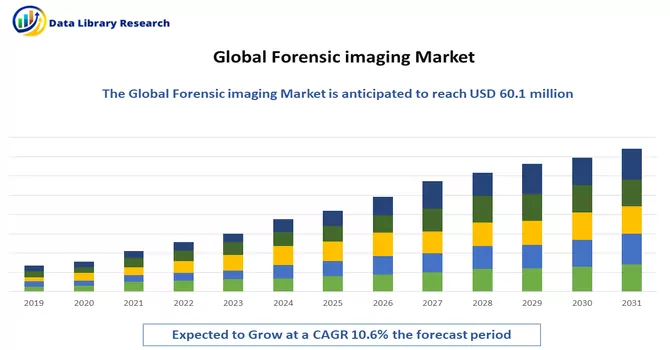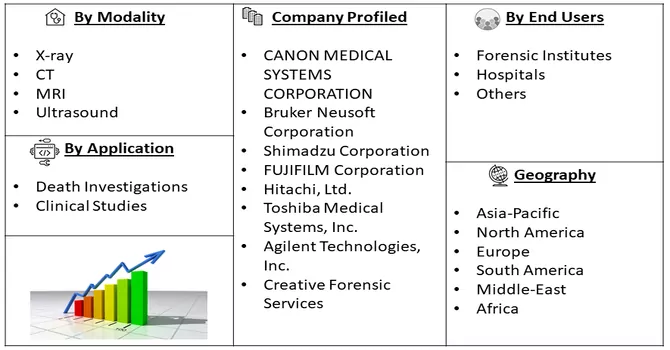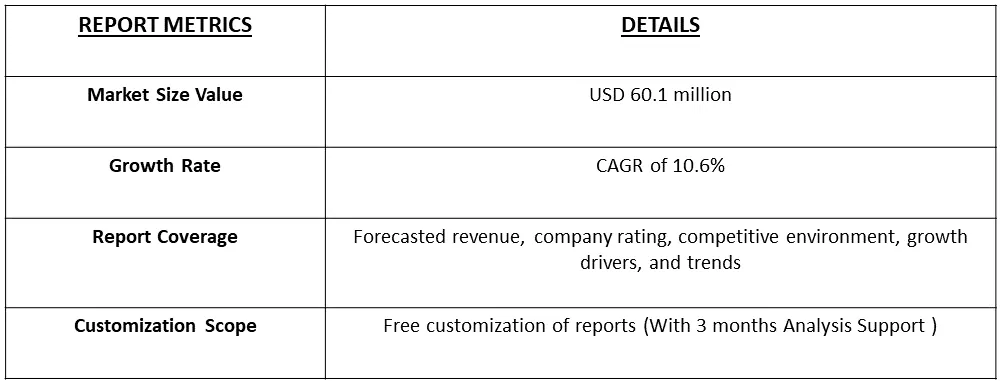The global forensic imaging market size was valued at USD 60.1 million in 2023 and is expected to grow at a compound annual growth rate (CAGR) of 10.6% from 2024 to 2031.

Get Complete Analysis Of The Report - Download Free Sample PDF
Forensic imaging refers to the specialized practice of capturing, analyzing, and interpreting visual information, typically in the form of photographs, digital images, or videos, for forensic purposes. This field plays a critical role in criminal investigations, legal proceedings, and forensic science by employing various imaging techniques to document and analyze evidence related to crimes. Forensic imaging encompasses a wide range of applications, including crime scene documentation, facial recognition, enhancement of surveillance footage, analysis of fingerprints, and the examination of medical images for forensic pathology. The goal is to provide accurate and reliable visual evidence that can aid investigators, forensic experts, and legal professionals in understanding, reconstructing, and presenting information relevant to a case in a court of law. Forensic imaging technologies continue to advance, contributing to more effective crime-solving and justice systems.
The increasing inclination towards virtopsy, or virtual autopsy, as a preferred method over traditional autopsy practices stands out as a prominent driver in the market. A heightened awareness of the advantages offered by virtual autopsy, either as an alternative or complement to the conventional "body opening" autopsy, has significantly propelled market expansion. The adoption of cross-sectional imaging modalities, including CT, MRI, X-ray, and ultrasound, in forensic examinations has revolutionized post-mortem medical investigations, enabling quicker and minimally invasive procedures. Furthermore, the integration of artificial intelligence and the broadening applications of these imaging modalities in tasks such as identifying the deceased and matching severed body parts are poised to create new avenues for market growth. This intersection of advanced technology and forensic sciences reflects a transformative shift towards more efficient and sophisticated methods in post-mortem analysis and investigation.
Market Segmentation: Global Forensic Imaging Market, by Modality (X-ray, CT, MRI, and Ultrasound), Application (Death Investigations and Clinical Studies), End-User (Forensic Institutes, Hospitals, and Others), and Geography (North America, Asia-Pacific, Europe, South America, Middle East, and Africa). The market size and demand forecasts for the pump market in revenue (USD billion) for all the above segments.

For Detailed Market Segmentation - Download Free Sample PDF
The Forensic Imaging Market is undergoing significant transformations driven by a range of compelling trends. Notably, there is a distinct shift towards virtopsy or virtual autopsy, gaining favour over traditional autopsy methods due to its non-invasiveness and rapid turnaround. Cross-sectional imaging modalities such as CT, MRI, X-ray, and ultrasound are increasingly integral in forensic examinations, enabling quicker and minimally invasive post-mortem investigations. Technological advancements in imaging, including improvements in resolution and speed, are enhancing the precision of forensic imaging techniques. The integration of artificial intelligence further elevates the capabilities of forensic imaging, offering advanced tools for image analysis, facial recognition, and pattern identification. Forensic imaging is expanding its applications, particularly in the identification of the deceased and matching severed body parts, contributing to the development of sophisticated forensic databases. Collaboration and data sharing among forensic experts, law enforcement, and medical professionals are on the rise, fostering a more holistic approach to investigations. The role of forensic imaging in mass disaster investigations is becoming increasingly crucial, leveraging its ability to handle large volumes of data efficiently.
Forensic Imaging Market Drivers:
Growing Preference for Virtopsy or Virtual Autopsy over Traditional Autopsy
There is a discernible shift in the field of forensic science marked by a growing preference for virtopsy, or virtual autopsy, over traditional autopsy methods. Virtopsy, leveraging advanced forensic imaging technologies, presents a non-invasive and technologically sophisticated alternative to the conventional "body opening" autopsy. This preference is fueled by several factors, including the speed and efficiency of virtopsy procedures, which eliminate the need for invasive post-mortem examinations. Forensic imaging, incorporating techniques such as CT scans, MRI, X-ray, and ultrasound, plays a pivotal role in the virtopsy approach. These cross-sectional imaging modalities enable forensic experts to conduct comprehensive examinations with unparalleled precision, offering detailed insights into internal structures and potential causes of death. The application of forensic imaging minimizes the need for invasive procedures, contributing to a more respectful and less intrusive post-mortem process. The use of virtopsy and forensic imaging has become integral in criminal investigations, aiding forensic experts in gathering crucial evidence while respecting ethical considerations. Beyond the advantages of non-invasiveness, these technologies facilitate the rapid examination of post-mortem cases, allowing for quicker analysis and timely release of findings. Thus, such factors are expected to drive the growth of the studied market over the forecast period.
Growing Awareness Regarding the Value of Virtual Autopsy
There is a notable surge in awareness regarding the significant value of virtual autopsy and forensic imaging within the realm of forensic sciences. This heightened awareness is reshaping traditional approaches to post-mortem examinations, with an increasing recognition of the benefits and applications offered by these advanced methodologies. Virtual autopsy, often referred to as virtopsy, has gained prominence as a non-invasive alternative or supplement to conventional autopsy methods. The awareness of virtopsy's advantages, such as reduced invasiveness, quicker turnaround times, and enhanced accessibility to forensic evidence, has contributed to its growing preference among forensic professionals and investigators. Forensic imaging, encompassing various technologies like CT scans, MRI, X-ray, and ultrasound, plays a pivotal role in this paradigm shift. The awareness surrounding the capabilities of forensic imaging in providing detailed and comprehensive visual data for analysis has led to an increased acceptance of these technologies in post-mortem investigations. Thus, such factors are expected to drive the growth of the studied market over the forecast period.
Market Restraints:
High Cost of Forensic Technologies
The integration of sophisticated forensic imaging technologies frequently comes with substantial initial expenditures related to equipment acquisition, training programs, and ongoing maintenance. The financial constraints faced by certain forensic departments and agencies present a formidable hurdle when considering the adoption of cutting-edge imaging solutions. The financial limitations may impede the ability of these entities to invest in state-of-the-art imaging technology, potentially slowing down the pace of technological advancement within their forensic practices. The challenge lies in balancing the imperative for advanced imaging capabilities with the fiscal realities that some forensic departments contend with, highlighting the need for strategic financial planning and potential collaboration to overcome budgetary limitations in advancing forensic imaging capabilities. Thus, such factors are expected to slow the growth of the studied market over the forecast period.
The forensic imaging market experienced a multifaceted impact due to the COVID-19 pandemic, with operational disruptions at the forefront. Lockdowns, social distancing measures, and restrictions on non-essential activities led to reduced caseloads for forensic imaging services, impacting demand during specific periods. Resource redirection became necessary, as forensic facilities and professionals prioritized support for the broader public health response. Delays in forensic investigations ensued, with limited access to crime scenes, postponed autopsies, and disruptions in evidence collection. Budget constraints stemming from the economic impact of the pandemic affected investments in new forensic imaging technologies or upgrades. Collaboration challenges emerged with remote working, impacting the seamless integration of forensic imaging into investigations. Despite these challenges, there was an increased demand for virtual solutions, accelerating the adoption of digital platforms and remote collaboration tools. The long-term impact on crime rates and criminal activities may reshape the demand for forensic imaging services, emphasizing the need for adaptability within the industry. The resilience of the forensic imaging market in navigating these challenges will be crucial in determining its future trajectory.
Segmental Analysis:
Ultrasound Segment is Expected to Witness Significant Growth Over the Forecast Period
Ultrasound, traditionally employed in medical diagnostics, has become an increasingly valuable asset in forensic imaging, offering a non-invasive approach to examining internal structures during post-mortem investigations. This technology proves particularly beneficial in cases where traditional autopsy methods may be challenging or culturally sensitive, providing detailed images of soft tissues and organs through high-frequency sound waves. Forensic ultrasound plays a pivotal role in trauma cases, revealing internal injuries that may not be immediately visible externally, and contributing to a more accurate understanding of the cause and manner of death. Additionally, it finds application in forensic obstetrics, aiding in the assessment of fetal development and identifying anomalies in cases involving pregnant individuals. Portable ultrasound devices are instrumental in mass disaster scenarios, facilitating rapid and efficient examinations in the field. While forensic ultrasound has limitations, such as reduced effectiveness in the presence of air or bone obstructions, its integration with other imaging modalities enhances the overall forensic investigation, showcasing its versatility and significance in the evolving landscape of forensic sciences.
Death Investigations Segment is Expected to Witness Significant Growth Over the Forecast Period
Death investigations in forensic science are significantly enhanced by the integration of advanced forensic imaging techniques. Forensic imaging plays a crucial role in providing detailed insights into the circumstances surrounding a death, aiding forensic experts in unravelling the complexities of the case. Technologies such as CT scans, MRI, X-ray, and ultrasound enable a non-invasive examination of internal structures, facilitating the detection of injuries, fractures, or abnormalities that may not be immediately apparent externally. In cases of traumatic deaths or suspicious circumstances, forensic imaging allows for a comprehensive analysis of soft tissues and vital organs, contributing to a more accurate determination of the cause and manner of death. It is particularly valuable in instances where traditional autopsy methods might be challenging or require a more respectful approach. Additionally, forensic imaging assists in the documentation and preservation of evidence, providing a visual record that can be crucial in legal proceedings. The integration of forensic imaging in death investigations exemplifies its significance in advancing the capabilities of forensic experts and ensuring a thorough and scientifically informed examination of the deceased.
Forensic Institute Segment is Expected to Witness Significant Growth Over the Forecast Period
Forensic institutes play a pivotal role in advancing the field of forensic sciences, and the incorporation of forensic imaging technologies has become integral to their investigative methodologies. These institutes serve as hubs for research, training, and the application of cutting-edge technologies to solve complex criminal cases. Forensic imaging, encompassing modalities such as CT scans, MRI, X-ray, and ultrasound, is a key component in the arsenal of tools employed by forensic institutes. Forensic imaging at these institutes facilitates detailed examinations of internal structures without the need for invasive procedures, contributing to more comprehensive post-mortem investigations. This technology proves especially valuable in cases where traditional autopsy methods may be impractical or face cultural sensitivities. Forensic imaging assists in visualizing injuries, fractures, and anomalies, providing forensic experts with critical information for determining the cause and manner of death. Forensic imaging within these institutes is not limited to post-mortem examinations but extends to various forensic disciplines. For example, in crime scene investigations, 3D imaging and reconstruction technologies aid in documenting and analyzing crime scenes, preserving crucial evidence for legal proceedings. Thus, these factors are expected to drive the growth of the studied market over the forecast period.
North America Region is Expected to Witness Significant Growth Over the Forecast Period
North America has emerged as a significant revenue contributor in the field of forensic imaging and is poised for continued growth in the forecast period. The region's growth is notably driven by a transition from a coroner system to a medical examiner system in the United States. This shift is anticipated to stimulate the demand for forensic imaging technologies as part of the evolving landscape in post-mortem investigations. However, this transition has also led to a shortage of pathologists in the U.S., particularly impacting autopsy examiner centers. The surge in demand for additional pathologists is expected in the coming years to address the increasing workload resulting from the shift in systems. Consequently, there is an anticipated rise in the adoption of advanced imaging technologies within autopsy centers across the U.S. This adoption is envisioned to streamline autopsy processes, potentially reducing the number of unnecessary autopsies performed and contributing to more efficient and precise forensic investigations in the region. Thus, these factors are expected to drive the growth of the studied market in the region over the forecast period.

Get Complete Analysis Of The Report - Download Free Sample PDF
In examining the competitive landscape of the forensic imaging market, comprehensive information is available for each competitor. This includes a detailed overview of the company, its financial standing, revenue generation, market potential, investment in research and development, and initiatives for entering new markets. A holistic assessment of the global presence of each competitor is provided, along with insights into their production sites, facilities, and capacities. The strengths and weaknesses of the companies are highlighted, offering valuable insights into their competitive positioning. Additionally, details on product launches, the scope of their product portfolios, and the extent of their applications in the market are covered. This data furnishes a focused perspective on each company's engagement specifically within the forensic imaging market, providing stakeholders with a comprehensive understanding of the strengths, strategies, and market presence of key players in the industry. The major players covered in the forensic imaging market report are:
Recent Developments:
1) In April 2020, Fujifilm announced its intention to acquire its competitor, Hitachi Medical Imaging, with the completion of the acquisition expected later in the year. However, the progress of the acquisition has experienced delays attributed to the impact of the global pandemic.
2) In January 2019, Canon unveiled the "Aquilion Start CT," a 16-slice CT scanner that is both cost-effective and compact in size. This new addition to their product line is specifically designed for forensic imaging services. The launch took place at the Arab Health 2019 event.
Q1. What was the Forensic Imaging Market size in 2023?
As per Data Library Research the global forensic imaging market size was valued at USD 60.1 million in 2023.
Q2. At what CAGR is the Forensic Imaging market projected to grow within the forecast period?
Forensic Imaging market is expected to grow at a compound annual growth rate (CAGR) of 10.6% over the forecast period.
Q3. What are the factors on which the Forensic Imaging market research is based on?
By Modality, By Application, End-User and Geography are the factors on which the Forensic Imaging market research is based.
Q4. Who are the key players in Forensic Imaging market?
Some key players operating in the market include
Data Library Research are conducted by industry experts who offer insight on industry structure, market segmentations technology assessment and competitive landscape (CL), and penetration, as well as on emerging trends. Their analysis is based on primary interviews (~ 80%) and secondary research (~ 20%) as well as years of professional expertise in their respective industries. Adding to this, by analysing historical trends and current market positions, our analysts predict where the market will be headed for the next five years. Furthermore, the varying trends of segment & categories geographically presented are also studied and the estimated based on the primary & secondary research.
In this particular report from the supply side Data Library Research has conducted primary surveys (interviews) with the key level executives (VP, CEO’s, Marketing Director, Business Development Manager and SOFT) of the companies that active & prominent as well as the midsized organization
FIGURE 1: DLR RESEARH PROCESS

Extensive primary research was conducted to gain a deeper insight of the market and industry performance. The analysis is based on both primary and secondary research as well as years of professional expertise in the respective industries.
In addition to analysing current and historical trends, our analysts predict where the market is headed over the next five years.
It varies by segment for these categories geographically presented in the list of market tables. Speaking about this particular report we have conducted primary surveys (interviews) with the key level executives (VP, CEO’s, Marketing Director, Business Development Manager and many more) of the major players active in the market.
Secondary ResearchSecondary research was mainly used to collect and identify information useful for the extensive, technical, market-oriented, and Friend’s study of the Global Extra Neutral Alcohol. It was also used to obtain key information about major players, market classification and segmentation according to the industry trends, geographical markets, and developments related to the market and technology perspectives. For this study, analysts have gathered information from various credible sources, such as annual reports, sec filings, journals, white papers, SOFT presentations, and company web sites.
Market Size EstimationBoth, top-down and bottom-up approaches were used to estimate and validate the size of the Global market and to estimate the size of various other dependent submarkets in the overall Extra Neutral Alcohol. The key players in the market were identified through secondary research and their market contributions in the respective geographies were determined through primary and secondary research.
Forecast Model
